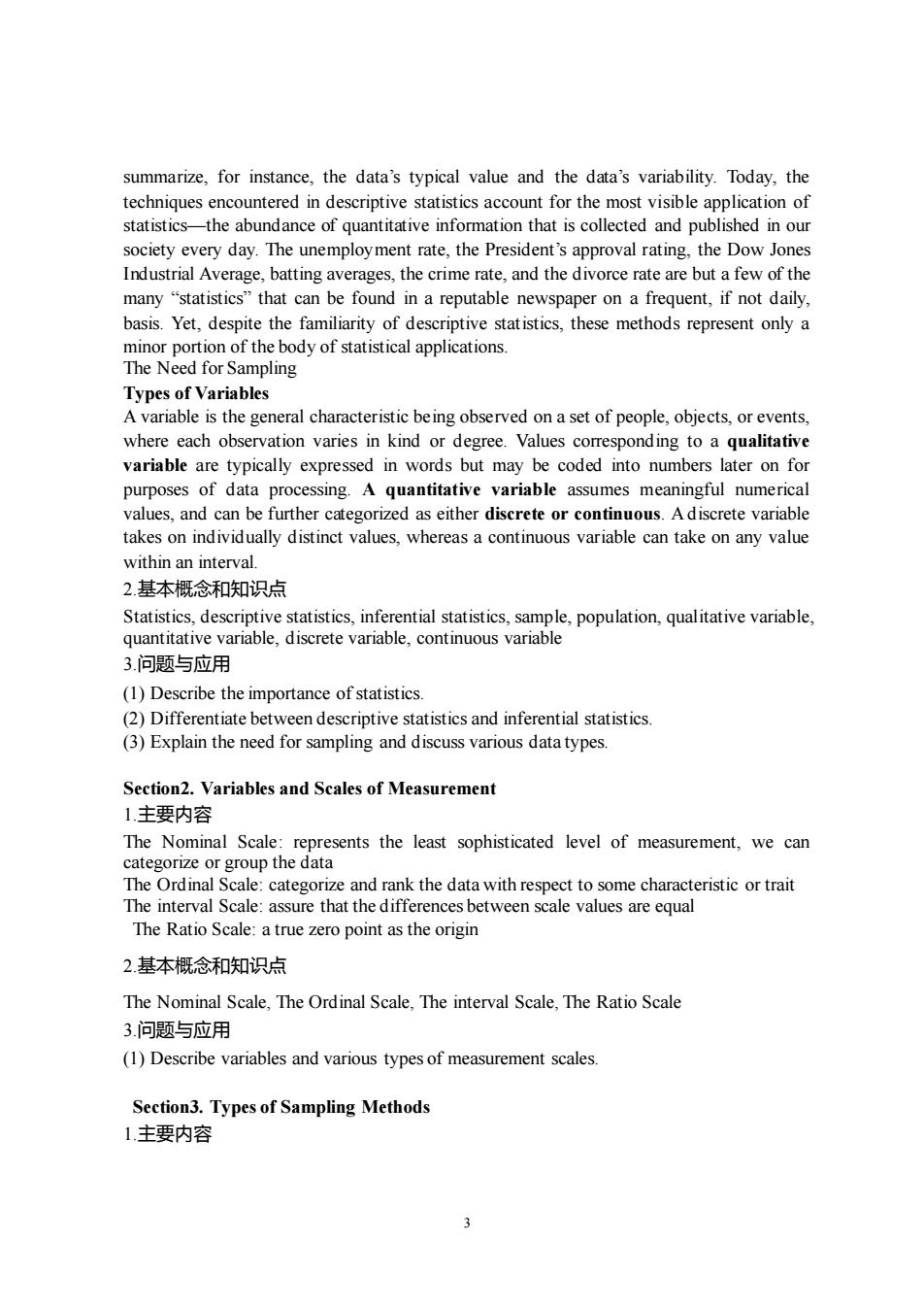正在加载图片...

summarize,for instance,the data's typical value and the data's variability.Today,the techniques encountered in descriptive statistics account for the most visible application of statistics the abundance of quantitative information that is collected and published in our ery day.The unemployment rate. the Pre Industrial Average,batting averages,the crime rate,and the divorce rate are but a few of the many "statistics"that can be found in a reputable newspaper on a frequent,if not daily, basis.Yet,despite the familiarity of descriptive statistics,these methods represent only a minor portion of the body of statistical applications The Need for Sampling Types of Variables A variable is the general characteristic being observed on a set of people, vents where each observation varies in kind or degree.Values corresponding to a qualitative variable are typically expressed in words but may be coded into numbers later on for purposes of data processing.A quantitative variable assumes meaningful numerical take son individually distinct values,wher e a an take on any value within an interval 2.基本概念和知识点 atistic ,infe uive variable. screte variable,continuous variabl 3问题与应用 (1)Describe the importance of statistics (2)Differentiate between descriptive statistics and inferential statistics. (3)Explain the need for sampling and discuss various data types. Section2.Variables and Scales of Measurement 1.主要内容 The Nominal Scale:represents the least sophisticated level of measurement,we can categorize or group the data The Ordinal Scale:categorize and rank the data with respect to some characteristic or trait The interva ale:assure that the differences between scale values are equal The Ratio Scale:a true zero point as the origin 2基本概念和知识点 The Nominal Scale,The Ordinal Scale,The interval Scale,The Ratio Scale 3.问题与应用 (1)Describe variables and various types of measurement scales Section3.Types of Sampling Methods 1.主要内容3 summarize, for instance, the data’s typical value and the data’s variability. Today, the techniques encountered in descriptive statistics account for the most visible application of statistics—the abundance of quantitative information that is collected and published in our society every day. The unemployment rate, the President’s approval rating, the Dow Jones Industrial Average, batting averages, the crime rate, and the divorce rate are but a few of the many “statistics” that can be found in a reputable newspaper on a frequent, if not daily, basis. Yet, despite the familiarity of descriptive statistics, these methods represent only a minor portion of the body of statistical applications. The Need for Sampling Types of Variables A variable is the general characteristic being observed on a set of people, objects, or events, where each observation varies in kind or degree. Values corresponding to a qualitative variable are typically expressed in words but may be coded into numbers later on for purposes of data processing. A quantitative variable assumes meaningful numerical values, and can be further categorized as either discrete or continuous. A discrete variable takes on individually distinct values, whereas a continuous variable can take on any value within an interval. 2.基本概念和知识点 Statistics, descriptive statistics, inferential statistics, sample, population, qualitative variable, quantitative variable, discrete variable, continuous variable 3.问题与应用 (1) Describe the importance of statistics. (2) Differentiate between descriptive statistics and inferential statistics. (3) Explain the need for sampling and discuss various data types. Section2. Variables and Scales of Measurement 1.主要内容 The Nominal Scale: represents the least sophisticated level of measurement, we can categorize or group the data The Ordinal Scale: categorize and rank the data with respect to some characteristic or trait The interval Scale: assure that the differences between scale values are equal The Ratio Scale: a true zero point as the origin 2.基本概念和知识点 The Nominal Scale, The Ordinal Scale, The interval Scale, The Ratio Scale 3.问题与应用 (1) Describe variables and various types of measurement scales. Section3. Types of Sampling Methods 1.主要内容